英语国际音标第二课时(20个元音音标)
48个国际音标
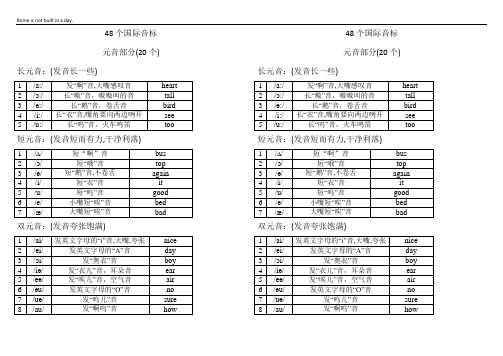
辅音部分(28个)
清辅音:(发音时声带不震动)
1
/p/
送气发拼音里的“p”
pig
2
/t/
送气发拼音里的“t”
top
3
/k/
送气发拼音里的“k”
kill
4
/f/
送气发“福”音,上牙齿咬下嘴唇
father
5
/θ/
送气咬舌发“s”音,舌头两齿之间
thank
6
/s/
送气发“s”,气流从舌尖齿龈缝中通过
good
4
/v/
出声发“5”音,上牙咬下嘴唇
very
5
/ð/
出声咬舌发“z”音,舌头两齿之间
this
6
/z/
出声发“z”,气流从舌尖齿龈缝中通过
zoo
7
/ʒ/
出声发“日”,舌前端贴住上齿龈后部
pleasure
8
/dʒ/
出声发“姐”音
Jeep
9
/dr/
出声发“绝”音
drink
10
/dz/
出声发“资”音
sure
8
/au/
发“啊呜”音
how
辅音部分(28个)
清辅音:(发音时声带不震动)
1
/p/
送气发拼音里的“p”
pig
2
/t/
送气发拼音里的“t”
top
3
/k/
送气发拼音里的“k”
kill
4
/f/
送气发“福”音,上牙齿咬下嘴唇
father
5
/θ/
送气咬舌发“s”音,舌头两齿之间
thank
6
/s/
送气发“s”,气流从舌尖齿龈缝中通过
国际音标(元音)完整版

eye fly why [ai] [flai] [wai]
able [eibl]
aim lazy pay [eim] [`leizi] [pei]
合口双元音
oil [ɔɪl]
boil join joy [bɔɪl] [dʒɔɪn] [dʒɔɪ]
out [aʊt]
our loud mouse [aʊr] [laʊd] [maʊs]
前元音
egg [eg]
any bed let [`eni] [bed] [let] 发音时舌尖抵下齿,舌前部稍 抬起,舌位比/i:/低;唇形中 常,开口度比/i:/大。
at [æ t]
bag am sad [bæ g] [æ m] [sæ d]
发音时舌尖抵下齿;舌前部稍 抬高,舌位比/e/更低;双唇 平伸,成扁平形。
ooze [u:z]
book [buk]
food root rude
[fu:d] [ru:t] [ru:d]
good look put
发音时舌后部抬起,舌身后缩,发音时[舌gu后d]部[尽luk量] 抬[pu起t],舌 舌尖离开下齿唇收圆,稍突出。 位比/u/高。双唇收圆并突出。
口形比/u/稍小。
区分音标20:10
后元音
all [ɔ:l]
Often [ `ɒtən]
always [`ɔ:lweiz] tall [tɔ:l]
发音时talk口张[t大ɔ:,k] 舌身尽量降 低并后缩,双唇稍稍收圆。
Off hot top [ɒf] [hɒt] [tɒp]
发音时舌后部抬得比高,双唇 收得更圆更小,并向前突出。
区分音标16:40
中元音
early [`ɜ:li]
最新二十个元音音标的学习2

元音的分类
单元音:/ i:/ / ɔ:/ / u:/ /ə:/ / ɑ:/ /ɪ/ /ɔ/ /ʊ/ /ə/ /Λ/ /e/ /æ/
双元音: /ei/ /ai/ /əu/ /au/ /ɛə/ /uə/ /iə/ /ɔi/
•
/ɔ:/ 1.舌端离开下齿,舌后抬高; 2.上下唇略张大,唇形较园, 并且用力向前突出 3. 气流从口腔中冲出,振动声 带,发 /ɔ:/音。
2.气流从,冲口腔冲出,振 动声带,发/u:/音。
例如:ruler move who room shoe
/u/ 1舌段离开下齿,舌后部向软腭抬 高,但舌位低于/ui:/音; 2双唇收缩成圆,但稍大于/u:/的 唇形,并稍向前突出; 3极为短促的气流从口腔冲出,振 动声带,发/u/音。
例如:put good would
例如:pork t talk ball door floor store
/ɔ/ 1.舌端离开下齿,舌身尽量降低 并后缩;
2.双唇自然成圆形,嘴角有紧 绷的感觉,保持口型不变;
3.一股极为短促的气流从口腔中 冲出,振动声带,发/ʊ/音。
例如:dog want
box wash what
/u:/ 1.舌端离开下齿,舌后部向软 腭抬高,双唇尽量收缩成圆而 且小,并稍向前突;
[ei]
[ei] 例词; face same game
hate late
例词:face same game hate late
hay
[ai]
例词:mind price night shy white high
[əu]
[ei] 例词; face same game
hate late
例词:road coat boat load cold smoke hope
英文国际音标表(48个)
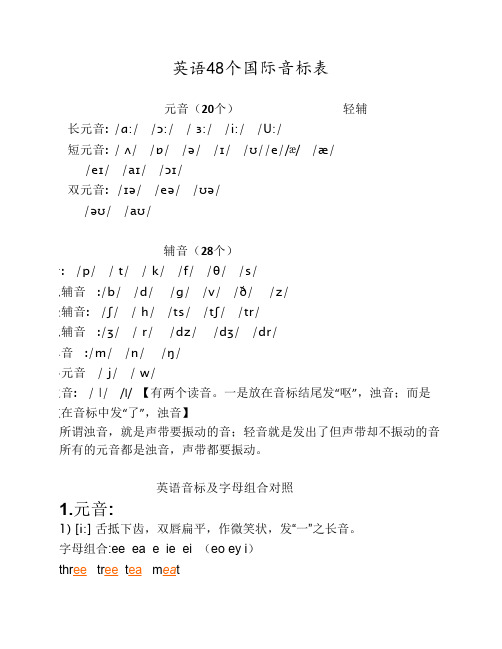
8) [t∫] 双唇微开,先用舌尖抵上齿龈,突然张开,使气流外动而成音, 发“吃”
音。 cheap check chair watch [dʒ] 双唇微开,先用舌尖抵上齿龈,突然张开,使气流外动而成音, 并震动 声带,发“之”音。发音字母 j ge jeep joke orange large 9) [h] 口半闭,气息由声门出来,但是不震动声带。
hour flower shower
2.辅音
1)[p] 双唇紧闭并使气流突破双唇外泄。(“泼”清音) Peach pie pig [b] 双唇紧闭并使气流突破双唇外泄, 且震动声带。 book big bye bird
2)[t] 双唇微开,先用舌尖抵上齿龈,然后突然张开,使气流外动而成 音。
tea boat neat to [d] 双唇微开,先用舌尖抵上齿龈,然后突然张开,使气流外动而成音, 并震动声
play light life like [r] 唇形稍圆,舌身略凹,舌尖上卷,震动声带。 red rain rest run [j] 双唇微开,舌抵下齿贴近硬颚,气流摩擦而出。
yes yet you young [w] 双唇突出,呈尖圆形,舌后升向软腭,气流流过震动声带。 wait way will west
音。 发音字母 u o ou oo cup bus love mother trouble blood 9) [ɔ: ] 双唇界于开闭,圆唇之间,牙床半开渐至全开,舌尖卷上再过 渡为卷后, 发“凹”声音拖长。 字母组合 al or au our ar small tall short more door floor caught autumn four warm 10) [ ɔ ] ([ɒ]) 双唇稍微向外突出成圆形,舌后升起,舌尖不触下齿, 发“凹” 短促的音。 发音字母 o a ou hot lot want wash 11) [u:] 双唇成圆形,牙床近于半合,舌尖不触下齿,自然而不用力, 发“屋” 之长音。 字母组合 oo o u food moon do two true blue 12) [u] 双唇成圆形,牙床接近半合,舌尖不触下齿,自然而不用力, 发短促之 “屋”音。
20个元音音标有哪些_20个元音音标正确读法

20个元音音标有哪些_20个元音音标正确读法20个元音音标有哪些?深入学习每个音标在单词中的用法,每个音标在词汇、句子中的讲解带读,真正做到学以致用,让你摆脱“哑巴英语”!一起来看看20个元音音标有哪些_20个元音音标正确读法,欢迎查阅!元音音标正确读法1美国英语和汉语是不一样2113的。
汉5261语是方块字,人们为了把字写4102得整齐美观,就在所写的材料画1653上方格,在方格内写字。
宋代活字印刷术出现后,人们就规则方块模字中造字,特别是近代出现的书写速度较慢的仿宋体、黑体、宋体,字体四棱方正,清晰易认,但这些字本身不表示任何声音,也就是说字和发音是完全不搭界的,比如说:“嬲”这个字,不念“男”,也不念“女”,而念“鸟”的音,也就是niao三声。
美国英语是拼音文字,由字母组成单字,它的发音是靠字母来表示的。
美国英语字母有26个,其中字母a、e、i、o、u是元音字母,其余21个是辅音字母,其中y字母有时当元音字母用。
每个字母可以有一个或一个以上的读音,因此,美国英语共有50个音位,音位的书写形式是音位字母,即音标符号,一个音位字母即音标,表示一个音位。
前元音/i//i/舌尖靠近下齿,舌前部上抬靠近硬腭,口型扁平,上下齿之间稍稍分开。
/?/舌位中高,口型扁平,上下齿之间可容纳一个小指尖。
/?/舌尖靠近下齿,舌前部稍稍抬起,口型扁平,上下齿之间可容纳一个中指。
/?/舌前部微微抬起,舌尖轻触下齿,双唇向两边平伸,张开口,上下齿之间可容纳一个食指和一个中指。
后元音/ɑɑ??u//ɑ/张开口,舌身平放后缩,舌面微微下凹,舌尖离开下齿。
/ɑ/口腔打开,口张大,舌头向后缩,双唇呈圆形。
/?/张开口,舌身低平后缩,双唇稍稍收圆,并向前突出。
凡发/ɑ/和/?/的字母后有r字母时,一律加卷舌音,发音的最后,舌尖要卷起,并往后翻。
/?/舌身后缩,舌后部向软腭抬起,舌位中高,双唇收圆,稍稍向前突出。
/u/舌身后缩,舌后部尽量向软腭抬起,舌尖离开下齿,双唇收圆,用力向前突出。
元音音标发音讲解20个
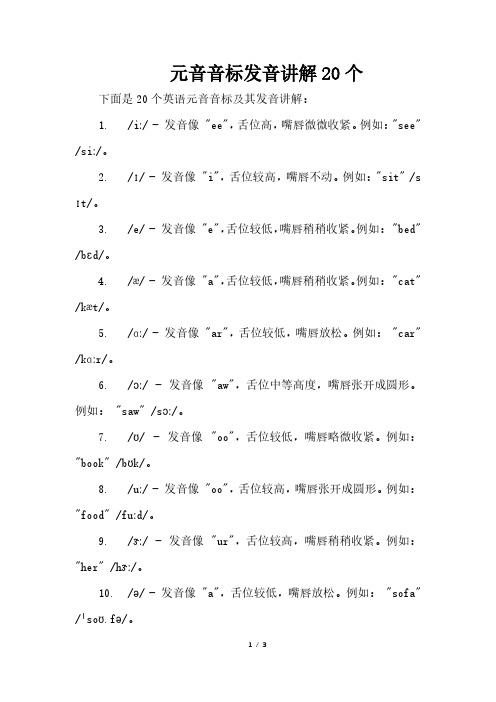
元音音标发音讲解20个下面是20个英语元音音标及其发音讲解:1. /iː/ - 发音像 "ee",舌位高,嘴唇微微收紧。
例如:"see" /siː/。
2. /ɪ/ - 发音像 "i",舌位较高,嘴唇不动。
例如:"sit" /s ɪt/。
3. /e/ - 发音像 "e",舌位较低,嘴唇稍稍收紧。
例如: "bed" /bɛd/。
4. /æ/ - 发音像 "a",舌位较低,嘴唇稍稍收紧。
例如: "cat" /kæt/。
5. /ɑː/ - 发音像 "ar",舌位较低,嘴唇放松。
例如: "car" /kɑːr/。
6. /ɔː/ - 发音像"aw",舌位中等高度,嘴唇张开成圆形。
例如: "saw" /sɔː/。
7. /ʊ/ - 发音像"oo",舌位较低,嘴唇略微收紧。
例如:"book" /bʊk/。
8. /uː/ - 发音像 "oo",舌位较高,嘴唇张开成圆形。
例如:"food" /fuːd/。
9. /ɝː/ - 发音像"ur",舌位较高,嘴唇稍稍收紧。
例如:"her" /hɝː/。
10. /ə/ - 发音像 "a",舌位较低,嘴唇放松。
例如: "sofa" /ˈsoʊ.fə/。
11. /eɪ/ - 发音像 "ay",舌位较高,嘴唇微微收紧。
例如:"day" /deɪ/。
12. /aɪ/ - 发音像"i",舌位较低,嘴唇稍稍收紧。
例如:"time" /taɪm/。
国际音标20个元音详细教学课件-小升初(最新修正)

52
/Iǝ/
beer deer ear dear fear near hear here
53
双元音 /eǝ/
前重后轻,舌端抵下齿,双唇半开。
发音组合:air ear are ere
54
/eǝ/
hair chair pear wear bare dare there where
__________________________________________________ _3_7________________________________________________
38
________________________________________
/e / /a / /ɔ / ________________________________________
发音组合: a
15
/æ/
am apple bat bag dad fat map math happy jacket thank that
16
前元音发音规律 /i:/→/I/→ /e/→ /æ /
舌尖抵下齿 舌前部抬起的高度逐步降低 牙床张开的程度逐渐加大
17
________________________________________
协会规定的一套音标,用来 记录ቤተ መጻሕፍቲ ባይዱ界上主要语言的语音。
2
3
国际音标
分类:英语中共有48个音标,元音20个,辅音28个。
{ { 单元音
元音
前元音 /i:/, /I/, /e/, /æ / 中元音 /ɜ:/, /ǝ/, /ʌ/ 后元音 /u:/, /ʊ/, /ɔ:/, /ɒ/, /ɑ:/
20个元音音标教学PPT

big
read
he
19
我们要学的第5个音标是?
/ʌ/
怎样发音? 嘴唇微微张开,伸向两边,舌尖轻触下齿,
舌后部稍稍抬起
20
元音/ʌ/ 发这个音的有字母u,o。
bus
rubber
mother
brother
21
拼读
/ pʌb / / b ʌs / /t ʌsk / /d ʌ v/ /k ʌp / /g ʌl /
部稍抬起
26
元音/ɜ: / 发这个音的字母组合ir,0r,ur。
girl
bird
worker
purple
27
谚语:The early bird catches the worm.
28
我们要学的第8个音标是?
/ə/
怎样发音? 嘴唇微微张开,舌身放平,舌中部稍微抬起,
比发/ɜ:/时放低些,口腔自然,轻松发声
she
he
bee
拍手拼读 /p i: / /b i: / /t i: / /d i: / /k i: / /g i: /
tea
15
我们要学的第4个音标是?
怎样发音? 嘴微开,舌尖抵下齿,舌前部抬高,嘴形扁平。
16
元音/ ɪ / 发这个音的字母有i,y。
fish
pig
ship
big 17
Let’s play a game!
38
元音/u: / 发这个音的字母组合oo,u,ui。
22
谚语:Love me,love my dog.
23
我们要学的第6个音标是?
/ɑ:/
怎样发音? 口腔打开,嘴张大,下巴放低,舌平放,
舌尖不抵下齿,轻松发音
英语国际音标第二课时(20个元音音标)PPT课件

4
元音和辅音
• 发音时声带振动,呼出的气流通过口腔时
不受阻碍,这样形成的语音称为元音。
• 不论声带振动与否 , 发音时呼出的气流通过
口腔或鼻腔时受到一定的阻碍,这样形成 的语音称为辅音。
• 发音时声带不振动的辅音称为清辅音。 • 发音声带振动的辅音称为浊辅音。
5
48个音标
6
• 元音是发音时声带振动,气流经过
12
• 1.短元音
单元音
/ɔ/是个后元音,是字母o在重读闭 音节单词中的读音。发音时口张大, 舌身尽量降低并后缩,双唇稍稍收 圆。
13
• 1.短元音
单元音
/u/是个后元音,是英语字母u,oo 或ou等在单词中的发音。/u/是短元 音。发音时舌后部抬起,舌身后缩, 舌尖离开下齿。双唇收圆,稍突出。
we look so long at the closed door that we do not see the one which has opened for us.
20
Silly Billy and His Family
• My friend Silly Billy has a big family. He keeps a very big house in a village
14
• 2.长元音
单元音
/i:/是个前元音,是字母ea,ee,ie 或ei在单词中的发音。此音是长元 音,一定注音把音发足。其发音要 领是发音时舌尖抵下齿,但不要抵 得太紧(不要发成汉语的“衣”) 前舌尽量抬高、舌位高于/i/,口形 扁平。
15
• 2.长元音
单元音
/ɔ:/是个后元音,是字母o,or,al, oar,our或oor在单词中的发音。 它是长元音。发音时舌后部抬得比 /ɔ/高,双唇收得更圆更小,并向前 突出。
英语音标表(48个)-美英不同读法
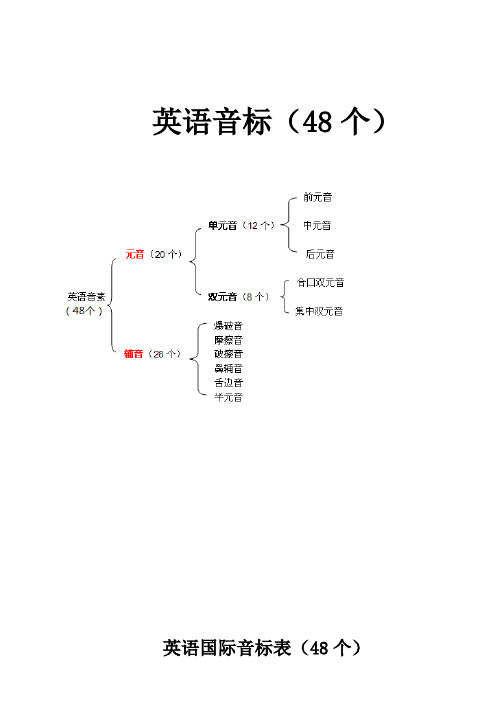
英语音标(48个)英语国际音标表(48个)一、元音(20个)说明:/ɒ/是单元音后元音,这个音标在英式音标中的符号是/ɒ/,旧版的国际音标符号是/ɔ/,美式音标与之对应有符号[ɑ]。
所以,这个音标应该是英式读哦,美式读啊二、辅音(28个)就是平舌音和卷舌音的区别,类似的/ts/和/tʃ/一样。
说明:/s/ 和/ʃ/浊辅音半元音/j/ 也/w/ 我浊辅音边音/ǀ/ 了浊辅音L有两个读音.一是放在音标结尾发:呕,浊音tal;而是放在音标中发:了,浊音n有两个读音.一是放在音标结尾发:嗯,浊音;而是放在音标中发:呢,浊音26个字母发音:单元音/i:/ 嘴唇微微张开,舌尖抵下齿,嘴角向两边张开,流露出微笑的表情,与字母E发音相同。
/i/ 嘴唇微微张开,舌尖抵下齿,舌前部提高,嘴形扁平。
/æ/ 嘴张大,嘴角尽量拉向两边,成扁平形,舌尖抵下齿。
/e/ 嘴形扁平,舌尖抵下齿,舌前部稍抬起。
/ə:/ 嘴形扁平,上下齿微开,舌身平放,舌中部稍抬起。
/ə/ 嘴唇微微张开,舌身平放,舌中部稍抬起,口腔自然放松发声。
/ɑ:/ 口腔打开,嘴张大,舌身放平,舌尖不抵下齿,下巴放低,放松发音。
/ ʌ/ 嘴唇微微张开伸向两边,舌尖轻触下齿,舌后部稍微抬起。
/u:/ 嘴形小而圆,微微外突,舌头尽量外缩。
/u/ 嘴唇张开略向前突,嘴形稍收圆并放松些,舌头后缩。
/ɔ:/ 嘴唇收的小而圆,并向前突出,舌身往后缩。
/ɔ/ 口腔打开,嘴张大,舌头向后缩,双唇稍收圆。
双元音/eɪ/ 由[e]和[i]两个单音组成,[e]重读,[i]轻读,口型由半开到合。
字母A就发这个音。
/aɪ/ 由两个单音组成,前音重读后音轻读,口型由开到合。
与字母I的发音相同。
/ɔɪ/ 由[כ]和[i]两个单音组成,前重读后轻读,双唇由圆到扁,口型从开到合,/aʊ/ 由[a]和[u]两个单音组成,[a]重读,[u]轻读,口型由大到小。
/əʊ/ 由[ə]和[u]两个单音组成,发音也是一个过程,口型由半开到小,与字母O的发音是相同的。
国际音标PPT课件
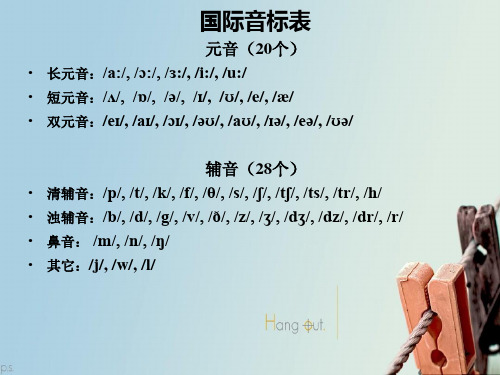
A: I have a bad cough. B: You must see a doctor. A: Yes, I must go to the hospital.
/ɑ:/
例词:
car garden star guitar
短语:
stars and bars星条旗 half mast降半旗 heart transplant心脏移植 fast car
例句:
A: I see two children on the blackboard.
B: He is short.
A: She is shorter.
/ɒ/- /ɔ/
例词:
cock公鸡 shop job hospital
短语:
hot coffee long job on the box drop the pot把锅放下
例句:
A: look at the clock!
B: what’s the time?
A: It’s a quarter to seven
/ʌ/
例词:
cup run jump flood
短语:
hurry up! trust us! rubbish dump垃圾堆 mustn’t worry
例句:
A: It’s sunny today. B: Yes, isn’t it. A: My uncle will go to London next
例句:
A: Look at my toy gun.
B: Oh, what a good toy!
A: Shall we join our friends in the garden? B: Yes, let’s go.
20个元音音标 (2)
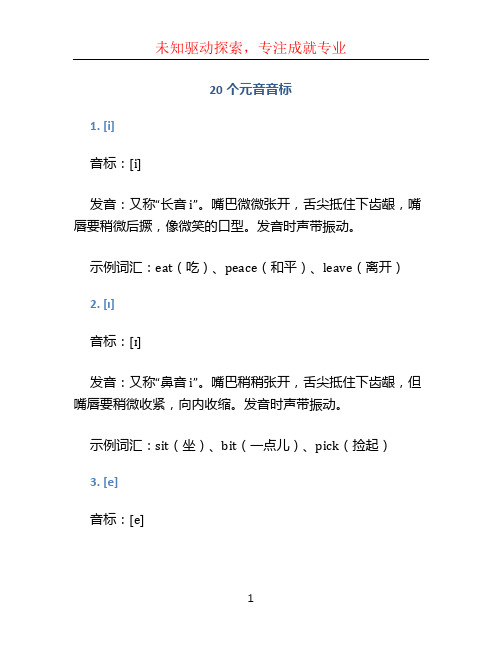
20个元音音标1. [i]音标:[i]发音:又称“长音i”。
嘴巴微微张开,舌尖抵住下齿龈,嘴唇要稍微后撅,像微笑的口型。
发音时声带振动。
示例词汇:eat(吃)、peace(和平)、leave(离开)2. [ɪ]音标:[ɪ]发音:又称“鼻音i”。
嘴巴稍稍张开,舌尖抵住下齿龈,但嘴唇要稍微收紧,向内收缩。
发音时声带振动。
示例词汇:sit(坐)、bit(一点儿)、pick(捡起)3. [e]音标:[e]发音:又称“长音e”。
嘴巴张开,舌头放置平展在口腔中央,嘴唇要张开成一个微笑的形状。
发音时声带振动。
示例词汇:red(红色)、bed(床)、get(得到)4. [æ]音标:[æ]发音:又称“短音a”。
嘴巴张开较大,舌头尽量放低,嘴唇要稍微收紧向内收缩。
发音时声带振动。
示例词汇:cat(猫)、hat(帽子)、mat(垫子)5. [a]音标:[a]发音:又称“长音a”。
嘴巴张开较大,舌头稍微放低,嘴唇要成圆形。
发音时声带振动。
示例词汇:father(父亲)、car(汽车)、start(开始)6. [ʌ]音标:[ʌ]唇要稍微后撅。
发音时声带振动。
示例词汇:cup(杯子)、luck(好运)、hut(小屋)7. [ɑ:]音标:[ɑ:]发音:又称“长音a”。
嘴巴张开较大,舌头稍微放低,嘴唇要稍微后撅。
发音时声带振动。
示例词汇:barn(谷仓)、bath(洗澡)、bar(酒吧)8. [ɔ:]音标:[ɔ:]发音:又称“长音o”。
嘴巴张开较大,舌头尽量放低,嘴唇要稍微向前突出。
发音时声带振动。
示例词汇:born(出生)、talk(说)、ball(球)9. [oʊ]音标:[oʊ]唇要稍微向前突出。
发音时声带振动。
示例词汇:boat(船)、road(路)、rose(玫瑰)10. [ə]音标:[ə]发音:又称“中央元音”。
嘴巴略微张开,舌头平放在口腔中央,嘴唇要稍微放松。
发音时声带振动。
示例词汇:about(关于)、among(在……之间)、again (再次)11. [eɪ]音标:[eɪ]发音:又称“长音e”。
国际音标表ppt课件

/dz/ 和/ts/发音相似,舌尖先抵住上齿龈,堵住气流, 使气流从舌尖和齿龈间送出,但声带需振动。 e.g. reads goods needs
为了规范事业单位聘用关系,建立和 完善适 应社会 主义市 场经济 体制的 事业单 位工作 人员聘 用制度 ,保障 用人单 位和职 工的合 法权益
为了规范事业单位聘用关系,建立和 完善适 应社会 主义市 场经济 体制的 事业单 位工作 人员聘 用制度 ,保障 用人单 位和职 工的合 法权益
5. /ʃ/ /ʒ/ /ʃ/ 双唇收圆,并稍微突出,舌头稍微上卷,舌尖接近上齿 龈送气,声带不振动。 e.g. flash shine fashion shop
为了规范事业单位聘用关系,建立和 完善适 应社会 主义市 场经济 体制的 事业单 位工作 人员聘 用制度 ,保障 用人单 位和职 工的合 法权益
4. /s/ /z/
/s/ 双唇微微张开,舌端靠近齿龈,舌头自然放松,气流 从齿间送出,但声带不振动。 e.g. best zest sun
/z/ /z/口形与/s/ ,双唇微微张开,舌端靠近齿龈, 舌头自然放松,气流从齿间送出,但声带需振动。 e.g. zero zoo jazz music
1. /p/ /b/
/p/ 双唇紧闭,然后快速张开,让气流冲出口腔,发 出爆破音,但声带不振动。
e.g. top pepper pick up
/b/ /b/和/p/发音相似,双唇紧闭,然后快速张开,让 气流冲出口腔,发出爆破音,但声带需振动。
e.g. Big Ben 英国大本钟 beautiful butterfly
英语国际音标20个元音的PPT

添加标题 04
[giv]
[өiŋk] ['priti]
[pen] [red]
[desk] [tſes]
01
[mæ p]
[æ nd] [bæ k]
03
02
[tel] [hed]
['eni]
04
[kæ mp] [hæ v]
[mæө]
[kΛp] [mΛnki]
[sΛm]
[mΛtſ]
[dζΛmp]
[gla:s] [ska:f]
[mu:n]
[buk] [gud]
[luk]
[kuk] ['wumən]
[ſuld]
[ə'baut] ['cinimə]
[ðə]
['pæ ndə]
['kæ mərə]
[bə:d] ['өə:sti]
[gə:l] [өə:d]
[ſə:t] [nə:s]
[keik] [weit]
[ðei] [ſeip]
[ba:ө] [bə'na:nə]
[fa:m]
[d כ:] [t כ: lk]
[ſ כ: t] [bi'k כ: s]
[dr כ: ]
[dכg] [w כſ ]
['k כpi] [s כŋ ]
['k כfi]
[blu:] [tu:ө]
[sku:l] [dζu:'lai]
e
2
添母在开音节中读字母音
4
添加标题
闭音节: 元音字母 + 辅音字母
5
添加标题
元辅结构
6
英语国际音标表(48个)word版

一、元音(一)、单元音1、前元音[ i: ] [ i ] [ e ] [ æ ]1)、[i:] 发音字母组合:ee ea e ie ei (eo ey i)音标特征:前元音舌位高不圆唇长元音发音要诀:舌前部抬得最高,牙齿近乎全合。
舌尖抵下齿。
舌前部向硬颚尽量抬起,但比汉语普通话“i”音稍低, 没有摩擦。
嘴唇向两旁伸开,成扁平行. 做微笑状,发[ i: ]长音。
注意:“:”是长音符号,长元音往往比它相应的短元音长两倍以上。
eat [ i:t ] 吃tea [ ti: ]茶peach [ pi:tʃ ]桃he [ hi:]他she [ ʃi: ]她beef [ bi:f ] 牛肉2)、[ i ] 发音字母组合: i y e ui u a音标特征: 前元音半高音扁平唇短元音发音要诀: 舌前部比[i:]稍低,比[e]高,舌尖抵下齿,嘴唇扁平分开。
牙床也开得稍大一些比[ i:]稍宽,比[ e ]窄。
上下齿之间的距离大约可以容纳一个小指尖。
使下颚稍稍下垂,舌前部也随之稍稍下降,即可发出短促[ i ]音。
fish [ fiʃ ] 鱼gym [ dʒim ] 健身房kid [ kid ] 小孩fifth [ fifθ ] 第五3)、[ æ ] 发音字母组合: a音标特征: 前元音低舌音不圆唇短元音发音要诀: 舌前部最低,双唇向两旁平伸,成扁平行牙床开的最大。
软颚升起, 唇自然开放上下齿之间的距离大约相当于一个食指加中指。
bag [ [bæg] ]包fan [ fæn ] 风扇math [ mæθ ]数学jacket [ 'dʒækit ] 夹克衫rabbit [ 'ræbit ] 兔子apple [ 'æpl ]苹果4)、[e] 发音字母组合:ea e a (ue,u,ie,ai,ei,ay)音标特征:前元音半高音不圆唇短元音发音要诀:舌尖抵下齿, 舌前部稍抬起, 舌后接近硬颚, 比[ i:] 低。
(word完整版)英语国际音标表(48个)word版
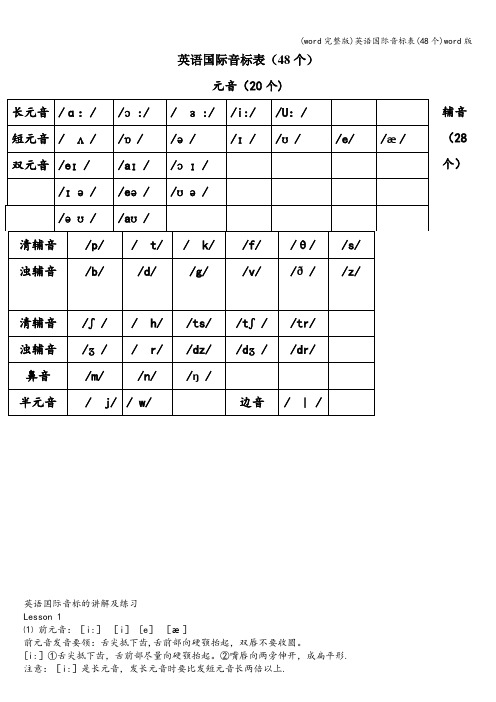
英语国际音标表(48个)元音(20个)(28个)英语国际音标的讲解及练习Lesson 1⑴前元音:[i:][i] [e][æ]前元音发音要领:舌尖抵下齿,舌前部向硬颚抬起,双唇不要收圆。
[i:]①舌尖抵下齿,舌前部尽量向硬颚抬起。
②嘴唇向两旁伸开,成扁平形.注意:[i:]是长元音,发长元音时要比发短元音长两倍以上.[i] ①舌尖抵下齿,舌前部向硬颚抬起,比[i:]低,比[e]高。
②唇形扁平,牙床开得比[i:]宽,比[e]窄。
③可从发[i:]出发,将小指尖放在上下齿之间,舌前部也随之稍稍下降,即可发出[i]。
[e] ①舌尖抵下齿,舌前部稍抬起,比[i:]低。
②唇形中常,牙床开得比[i:]宽,上下齿间可容纳一个食指。
[æ]①舌尖抵下齿. ②双唇向两旁平伸,成扁平形,两齿间可以容纳食指和中指。
⑵爆破辅音:[p] [b] [t] [d] [k] [g]爆破音发音要领:[p] [t] [k]是清辅音,发音时声带不振动,送气要强。
[b] [d] [g]是浊辅音,发音时声带必须振动,送气要强。
[p] [b]双唇紧闭,然后突然分开,气流冲出口腔.[t] [d]舌尖紧贴上齿龈,形成阻碍,然后突然下降,气流冲出口腔.[k] [g]舌后部隆起,紧贴软颚,形成阻碍,然后突然离开,气流冲出口腔。
⑶发音练习: b[bi:] d[di:] e[i:]Lesson 2⑴ 后元音:[ɑ:] [ɔ] [ɔ:] [u] [u:]后元音发音要领:①舌尖不触下齿,舌身后缩,舌后部向软颚抬起,除[ɑ:]外,双唇要收圆.②发[ɑ:][ɔ:][u:]时要注意长度,不要发得太短。
[ɑ:] 舌尖不触下齿,口张大,舌身平放后缩。
[ɔ]①舌尖不触下齿,口张大,舌身尽量降低并后缩.②双唇稍稍收圆。
③可先发[ɑ:],然后将舌身再稍稍向后缩,双唇稍稍收圆(不要突出)即可发出[ɔ]。
[ɔ:]①舌后部比发[ɔ]时抬得略高。
②双唇也收得更圆更小,并须用力向前突出.[u] ①舌尖不触下齿,舌后部向软颚抬起,舌身后缩。
英语国际音标表(48个)word版
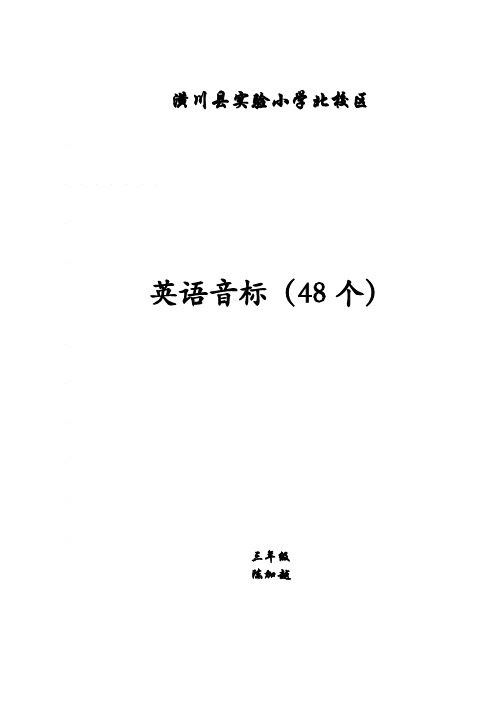
潢川县实验小学北校区英语音标(48个)三年级陈加越英语国际音标表(48个)一、元音(20个)二、辅音(28个)单元音/i:/嘴唇微微张开,舌尖抵下齿,嘴角向两边张开,流露出微笑的表情,与字母E发音相同。
/i/嘴唇微微张开,舌尖抵下齿,舌前部提高,嘴形扁平。
/æ/ 嘴张大,嘴角尽量拉向两边,成扁平形,舌尖抵下齿。
/e/嘴形扁平,舌尖抵下齿,舌前部稍抬起。
/ə:/嘴形扁平,上下齿微开,舌身平放,舌中部稍抬起。
/ə/嘴唇微微张开,舌身平放,舌中部稍抬起,口腔自然放松发声。
/ɑ:/口腔打开,嘴张大,舌身放平,舌尖不抵下齿,下巴放低,放松发音。
/ ʌ/嘴唇微微张开伸向两边,舌尖轻触下齿,舌后部稍微抬起。
/u:/嘴形小而圆,微微外突,舌头尽量外缩。
/u/嘴唇张开略向前突,嘴形稍收圆并放松些,舌头后缩。
/ɔ:/嘴唇收的小而圆,并向前突出,舌身往后缩。
/ɔ/口腔打开,嘴张大,舌头向后缩,双唇稍收圆。
双元音/eɪ/由[e]和[i]两个单音组成,[e]重读,[i]轻读,口型由半开到合。
字母A就发这个音。
/aɪ/由两个单音组成,前音重读后音轻读,口型由开到合。
与字母I的发音相同。
/ɔɪ/由[כ]和[i]两个单音组成,前重读后轻读,双唇由圆到扁,口型从开到合,/aʊ/由[a]和[u]两个单音组成,[a]重读,[u]轻读,口型由大到小。
/əʊ/由[ə]和[u]两个单音组成,发音也是一个过程,口型由半开到小,与字母O的发音是相同的。
/ɪə/ 由[i]和[ə]两个单音组成,[i]重读,[ə]轻读,双唇始终是半开的。
/eə/由[e]和[ə]两个单音组成,前重后轻,舌尖抵下齿,双唇半开。
/ʊə/两个单音组成,[u]重读,[ə]轻读,双唇由收圆到半开。
辅音音素/p/双唇紧闭,然后快速张开,让气流冲出口腔,发出爆破音,但声带不振动。
/b/双唇紧闭,然后快速张开,让气流冲出口腔,发出爆破音,但声带需振动。
/ t/舌尖抵上齿龈,憋住气,然后突然弹开舌尖,让气流从口腔中喷出,但声带不振动。
- 1、下载文档前请自行甄别文档内容的完整性,平台不提供额外的编辑、内容补充、找答案等附加服务。
- 2、"仅部分预览"的文档,不可在线预览部分如存在完整性等问题,可反馈申请退款(可完整预览的文档不适用该条件!)。
- 3、如文档侵犯您的权益,请联系客服反馈,我们会尽快为您处理(人工客服工作时间:9:00-18:30)。
2.长元音
单元音
/u:/是个后元音,是字母oo或ou在 单词中的发音。它是长元音。发音 Байду номын сангаас舌后部尽量抬起,舌位比/u/高。 双唇收圆并突出。口形比/u/稍小。
2.长元音
单元音
/ә:/是个中元音,是字母组合er,ir, or和ur在单词中的发音。发音时舌 中部比发/ә/音时略高。双唇扁平。
2.长元音
双元音
/eә/是字母are,air,ear在单词中的读 音。其发音方法是从/e/音滑向/ә/音。发 间时舌端抵下齿,前舌略抬起,双唇半 开。
双元音
/uә/是字母our,oor,ure在单词中 的读音。发音时,嘴唇从收圆到半 开。发好这个音的关键是首先要把 /u/音发足,然后滑向/ә/音。
大声朗读下面的词语,注意其中元音的变化。
单元音
/a:/是个后元音,是字母组合ar的 读音,也是字母a在ss,st,th等字 母前面的读音。/a:/是长元音。发 音时口张大,舌身压低并后缩,后
舌稍隆起,舌尖不抵下齿。双唇稍 收圆。
单元音综合练习
1. He who is afraid to ask is ashamed of learning. 2. None are so empty as those who are full of themselves. 3. Among my most prized possessions are words that I have never spoken. 4. We love those who know the worst of us and don’t turn their faces away. 5. When one door of happiness closes, another opens; but often we look so long at the closed door that we do not see the one which has opened for us.
音素和国际音标
1.什么是音素:音素是语音的最小单位。 2.音素的分类:元音和辅音。 3.音素的个数:共48个,元音音素20个,辅
音音 素28个。 4.什么是音标:记录音素的符号叫做音标。 5.什么是国际音标:国际音标是由国际语音
协会规定的一套音标,用来 记录世界各主要语言的语音。 7. 开音节:a) 辅音+元音+辅音+e : name, bike, home, due, plane, shine b) 辅音+元音: he, go, hi, do, be, tree, three, hello 8. 闭音节:a) 辅音+元音+辅音: bad, bed, sit, hot, cup,let, mad, map b)元音+辅音: it,is, of, in, on, up, out, ant 9.重读音节:单词中发音特别响亮的音节。
辅
音
3个鼻音
音
[m] [n] [η]
3个似拼音
[h] [r] [l]
2个半元音
[w] [j]
元音是发音时声带振动,气流经过 口腔和咽头不受阻碍而发出的声音。 英语元音共有20个,其中单元音12 个,双元音8个。元音是音节中最 核心的音素,因此,元音发得是否 到位,决定了发音的质量和效果。
1.短元音
单元音
/i/是个前元音,是字母i或y在重读 闭音中的读音。它是个短元音,故 发此音要短促而轻快。发音要领的 是:舌尖抵下齿,舌前部抬高,舌 两侧抵上齿两侧,口形偏平。
1.短元音
单元音
/e/是个前元音,是字母e或ea在单 词中的发音。它是个短元音。发音 时舌尖抵下齿,舌前部稍抬起。口 略开,口型自然放松。
双元音
/әu/是字母o,oa和oe在单词中的读 音。它由元音/ә/滑向后元音/u/,舌 位由半低到高,口形由半开到小。 注意将音发足。
双元音
/au/是字母ou和ow在单词中的读音。 /au/由/a/滑向/u/。舌位由低到高, 口形由大到小。注意将音发足。
双元音
/iә/是字母ear,ere,eer在单词中的读 音。其发音要领是从/i/音滑向/ә/音。前 面的/i/发得较清楚,后面的/ә/较弱。双 唇始终半开。此音一定要发足。
元
音
短元音 [Λ] [ә] [i] [ɔ] [u] [æ ] [e]
8个双元音
[ai] [ei] [ɔi] [iә ] [eә ] [uә ] [au] [әu]
清 辅 [p] [t] [k] [f] [s] [∫] [t∫] [tr] [θ] [ts]
10 音
对 浊 辅 [b] [d] [g] [v] [z] [3] [d3] [dr] [ð] [dz]
5)keep, kid, kept, cap, cake, cart, kite, care, cool, cold, coward, coin, call, cook, cock, curtain, cure.
朗读下面的短篇,注意其中双元音的发音以及不同双元音之间的区别。
This, Too, Shall Pass Away
Silly Billy and His Family
My friend Silly Billy has a big family. He keeps a very big house in a village by a river. And on the river he keeps a ship and in the ship he keeps a sheep. In his big, big house, my friend Silly Billy keeps a horse, a cook and a cock.
1.短元音
单元音
/ æ/是个前元音,是字母a在重读闭 音节中的发音。/æ/是短元音。发 音时舌尖抵下齿;舌前部稍抬高, 舌位比/e/更低;双唇平伸,成扁平 形。
1.短元音
单元音
/Λ/是个后元音,是字母o和u在单 词中的读音。/Λ/是短元音。发音 时舌尖和舌端两侧轻触下齿,舌后 部靠前部分稍抬起,唇形稍扁,开 口度较大,与/æ/相似。
When some great sorrow, like a mighty river, flows through your life with peace-destroying power, and dearest things are swept from sight forever, say to your heart each trying hour: “This, too, shall pass away.” When ceaseless toil has hushed your song of gladness, and you have grown almost too tired to pray, let this truth banish from your heart its sadness, and ease the burdens of each trying day: “This, too, shall pass away.” When fortune smiles, the days are flitting by without a care, lest you should rest with only earthly treasure, let these few words their fullest import bear: “This, too, shall pass away.” When earnest labor brings you fame and glory, and all earth’s noblest ones upon you smile, remember that life’s longest, grandest story fills but a moment in earth’s little while: “This, too, shall pass away.”
双元音
英语中的双元音由两个元音组合而成,第一 个元音向第二个元音滑动,滑动过程中没有 任何停顿。第一个音长而响亮,第二个音短 而含糊。发音时没有任何摩擦。
双元音与单元音的不同之处在于:单元音在 发音时发音器官自始至终保持某一固定位置, 而双元音要完成从一个单元音到另一个单元 音的滑动。英语有8个双元音。
双元音
/ei/是字母a在重读开音节单词中的 读音。先发/e/音,然后滑向/i/音。 双唇稍扁,口形从半开到合。
双元音
/ai/是字母i或y在单词中的发音。先 发/a/音,然后滑向/i/音。舌尖抵住 下齿。发此音的关键是要把/a/音发 足,注意从开到合的滑动。
双元音
/ɔi/是字母oy和oi在单词中的发音。 发音时双唇从圆到扁,口形从开到 合。发好这个音的关键是首先要把 后元音/ɔ/发足,然后滑向/i/音。
One winter, my friend, Silly Billy, went out for a walk. The cook took a knife and wanted to kill the cock. The cock ran for its life. It flew and sat on the horse. The horse was afraid, it ran out of the house. When it got to the river, it wanted to get on the ship. But it slipped. So down into the river went the horse, the ship and the sheep.
1)beat, bit, bet bait, bat, bite, barn, boot, boat, bought, bird, bout, boss, book, bear, beer, buyer.
